
The Surprising Connection Between Hips and Jaw Pain
How adapting my holistic approach to treating TMJ Dysfunction transformed my results.
Chronic pain, otherwise known as persistent pain, is pain that continues for more than 12 weeks.
This timeframe is significant as most tissue damage repairs within 12 weeks, suggesting there is more to pain than just the initial physical injury.
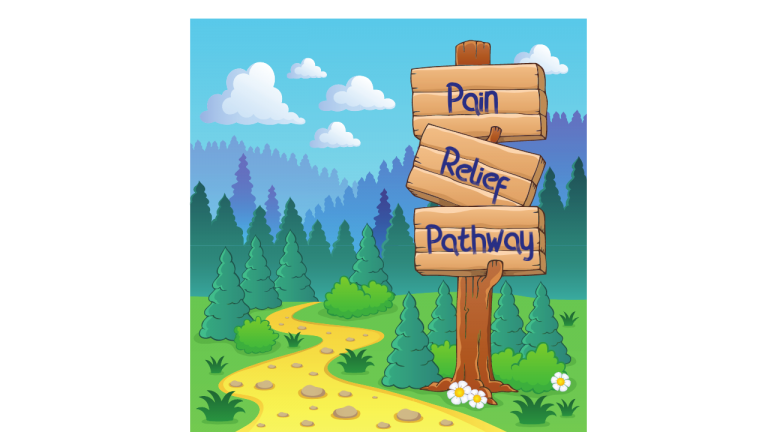
Chronic pain is complex. What we know now, is that the brain is in charge. The brain determines that the pain exists, whether there is tissue damage or not.
Understanding how pain works and what we can do to relieve it, is our pathway to pain relief.
My chronic pain is real. My brain turns up the volume to protect me. My brain is influenced by past experiences, stress, anxiety, and daily events.

Our chronic pain is real. We know it’s real. In fact, if people don’t believe us, or trivialise our pain, it can contribute to making things worse.
Pain is complex and we are still learning how it works. However, arming ourselves with some knowledge around pain, can help us on our path to recovery.

Arming ourselves with knowledge about chronic pain can help us with recovery.
A helpful analogy for pain is an office fire alarm. The fire alarm sounds when there is danger, such as when smoke hits a smoke detector.
Similarly, we feel pain when we are in danger. When tissue is damaged by a cut, a burn, a strain, or a sprain, we feel pain.
The pain is an alarm telling us to take action. This may mean moving away from a sharp object or flame, or ceasing an action that is causing tissue damage.

A helpful analogy for pain is an office fire alarm.
However, fire alarms also sound when there is no danger. A fire break-glass can be triggered accidentally, or there could simply be a fire drill.
Similarly, not all pain means damage or danger.
Our brains are in charge of perceiving chronic pain. We now know that the brain tries to protect us, based not only on actual danger, but perceived danger influenced by a number of unconscious factors, including past experiences.

As with taste and smell, our brain calls on past pain experiences to try to protect us.
When I passed my school exams at age 16, I decided to celebrate with some alcohol, smuggled into the school thanks to a friend’s older sister. I was very inexperienced with alcohol and don’t recall what event led to the choice of a bottle of Dry Martini.
I’m embarrassed to say now, that I could have died of asphyxiation, I was so violently sick. Nearly 40 years on, I still feel queasy at the faintest whiff of Dry Martini.
My brain has associated Dry Martini with danger. So much so, that I cannot possibly entertain the thought of even smelling it. No doubt you have had similar alarm bell experiences with taste or smell?
Similarly, our brain takes past experiences into account when signalling a potential danger to our body. If we’ve previously been bent double with back pain, when the brain now feels a slight twinge, it can over react and create significant pain without there being any damage at all.

Irene Tracey discovered the brain can experience pain without a physical stimulus.
We know the brain can create pain without a physical stimulus thanks to scientists like Irene Tracey. Along with her team, Tracey conducted studies on the brain using functional magnetic resonance imaging (FMRI).
They discovered they could stimulate a pain response in their (human) subjects both with and without a physical source of pain.
They were able to do this through suggestion alone. This was enough to convince the subjects’ brains to produce pain – and to sound the alarm!
So past experiences, anxiety, fear and even anticipation, can all create pain.
Through mindfulness, self-massage and movement, I can reassure my brain. When the brain perceives less danger, it releases its protective hold.

Knowing how pain works is our first reminder. Believing recovery is within our own control is our second reminder.
Our pain can become worse when we meet negative or unhelpful input from others.

Physical activity can reassure the brain and help to relieve pain.
We’ve all experienced people, even medical professionals, not take our pain seriously. So it’s important we have faith in ourselves and are willing to take ownership of our own recovery.
Recovery is within our control.
In addition to reminding ourselves daily, that the brain is simply trying to protect us, we can also positively influence the brain through mindfulness meditation, self-massage and movement.
Finding a quiet space and bringing attention to my breath and body – even for 5 minutes, can help to turn down the volume.
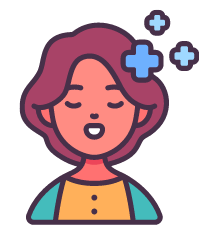
Mindfulness may be the current buzz-word, but it has been practiced for centuries.
In the ancient Buddhists texts of the Pali Canon, there is a teaching by the Buddha to his monks called “The Arrow.”
The Buddha likens our experience of pain, to that of a man being shot with an arrow, then immediately after, being shot with another arrow. Like the man experiencing the pain of two arrows, so do we.

The Buddha used the analogy of being hit by a second arrow to describe our response to pain.
The first arrow, the Buddha explained, is the pain caused by the arrow piercing the flesh. The second is the pain of the emotion we bring to it.
Catastrophizing the event increases anxiety, fear, worry, stress and – more physical pain.
Whilst it is true that stress, anxiety and worry can increase our pain, it is also true that we can adopt simple practices to reduce our stress, anxiety and worry – in turn, reducing our pain.
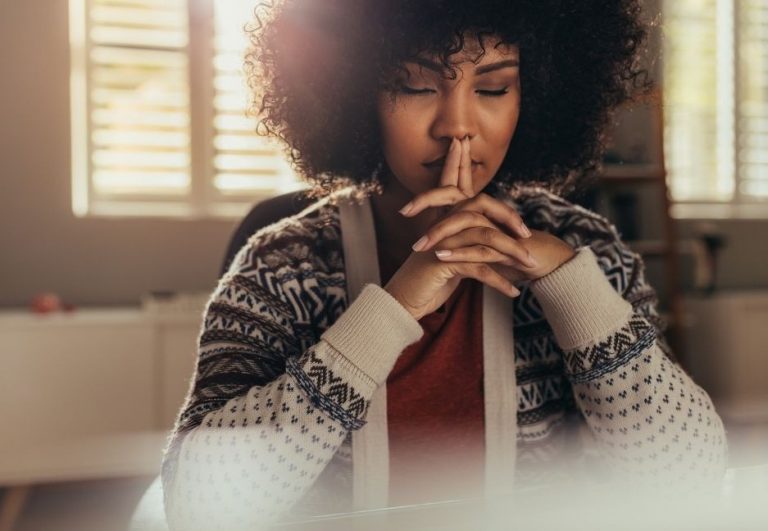
Mindfulness meditation can help to reduce pain.
Whilst the Buddha may have been teaching meditation to calm the pain of the second arrow 150 years ago, recent studies on the brains of meditators have proven that meditation can create positive physiological changes in the brain.
Today, mindfulness meditation is practiced widely to reduce stress, anxiety, illness and pain. This is in large part thanks to the work of Jon Kabat-Zinn.
Kabat-Zinn studied meditation with some of the foremost Buddhist teachers of the day, including Thich Nhat Hanh and Philip Kapleau.

John Kabat-Zinn helped grow the awareness of meditation as a means to relieving chronic pain.
He went on to strip away the Buddhist framework to teach meditation for the purpose of reducing stress.
His book Full catastrophe living: using the wisdom of your body and mind to face stress, pain, and illness opened the doors of meditation for the treatment of pain to the masses.
Thankfully, we don’t need to over-complicate mindfulness meditation. It is as simple as finding some space for ourselves and bringing a kind curiosity to our breath and our body.
There are lots of meditation resources available to us, such as the apps Calm and Headspace. There is also a free app called Insight Timer.
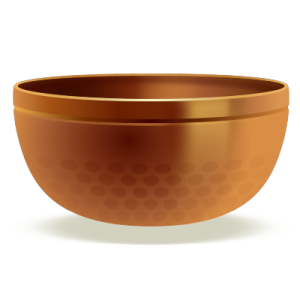
This app has dozens of teachers offering free guided meditations for sleep, anxiety and stress. There is the option to make a donation to the teacher.
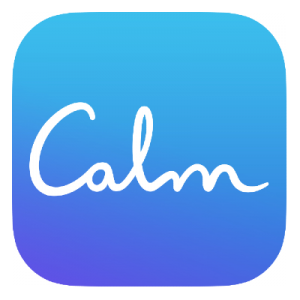
The Calm app is subscription based with a free 7 day trial. It has many guided meditations for sleep, relaxation and stress relief.

Headspace is a popular app with engaging guided meditations. Like Calm, Headspace is subscription based with a 7 day trial.
Here are two free short guided meditations which can help us with positive emotions to help reduce our stress and chronic pain.
Touch is calming. Exploring areas of tension with curiosity can reveal tender trigger points. Applying pressure for 8-12 seconds helps release the tension.

There’s a good reason I am a massage therapist. I truly believe in the power of touch. Yes, there are massage techniques that may directly release tissue tension; however, massage of course is more holistic than that – it also helps calm the mind.
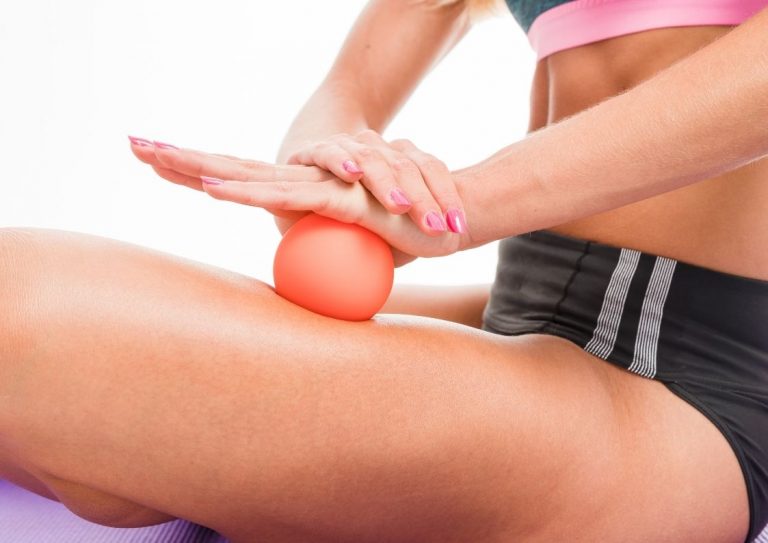
Self-massage is self-care – sending calming signals to the brain.
Self-massage is self-care. Similar to a self compassion meditation, self-massage sends calming signals to the brain. This in turn helps turn down the pain volume.
Self-massage can be done with a soft fist, fingers, or a massage ball.
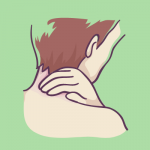
Go easy. You know your body better than anyone. So go gently and in a way that’s safe for you.
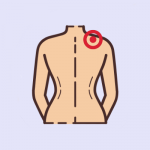
When self-massaging, we’re seeking out tender spots, known as trigger points.

When you feel a tender spot, hold the pressure for 8-12 seconds.

Not too much pressure – no more than a 7 out of 10 on a pain scale.
Moving within my pain threshold reassures my brain that all is ok. The brain releases its hold and allows me to move more freely.

Whether it is a boogie in the front room or a power walk around the block, moving is simply the best thing we can do to relieve chronic pain.
You know the old saying – “If you don’t use it, you’ll lose it!”
Using our muscles and flexing our joints doesn’t just create a stronger healthier body. This NHS webpage on exercise calls it a miracle cure.
One benefit of course is reducing stress – and we already know that stress is a major contributor to us experiencing more pain.

Movement is is the best thing for chronic pain.
I’m calling this movement rather than exercise. Katy Bowman, the renowned biomechanist and author of Move Your DNA: Restore Your Health with Natural Movement quite rightly reminds us that we can be put off by the thought of exercise or exercises – but moving feels a bit more do-able.
Moving within our pain threshold signals to the brain that all is ok. We will feel discomfort, but we want to keep that below a 7 out of 10 on the pain scale. Any higher and it simply won’t help.
However, testing our range of motion will gradually help the brain release its hold and allow us to move more freely.
In this lecture, Katy Bowman explains the difference between exercise and movement.
For us to incorporate movement as part of our recovery, we need to find something we enjoy.
That gives us more chance of sticking to it. Here are some ideas:
I personally find Tai Chi is excellent for my own chronic back pain. It brings together awareness of the breath, awareness of the body and movement of the body.
It also helps to engage and strengthen the gluteus muscles. These are the ones that we leave under utilised with our prolonged sitting.
This Tai Chi exercise is also available as a mobile app.
I firmly believe that walking is the best treatment for low back pain. Even if it is uncomfortable to start, persevering will warm up the muscles and reassure the brain.
Here’s a short walk you can do without leaving the living room. Just go easy and stay within a comfortable pain threshold.
Here’s a short walk video – 1 mile without even leaving the living room!
If you fancy a turbo boosted walk, how about Nordic walking? The sticks can give some stability and help to grow confidence.
Here’s a video introduction to see what it’s all about.
Here’s a video showing the basics of Nordic walking
There we have it. If we are really looking at how to relieve chronic pain, I highly recommend turning to these 5 transformative reminders.
Download this high resolution infographic of the 5 reminders, so you can have them at hand when you need them.

How adapting my holistic approach to treating TMJ Dysfunction transformed my results.
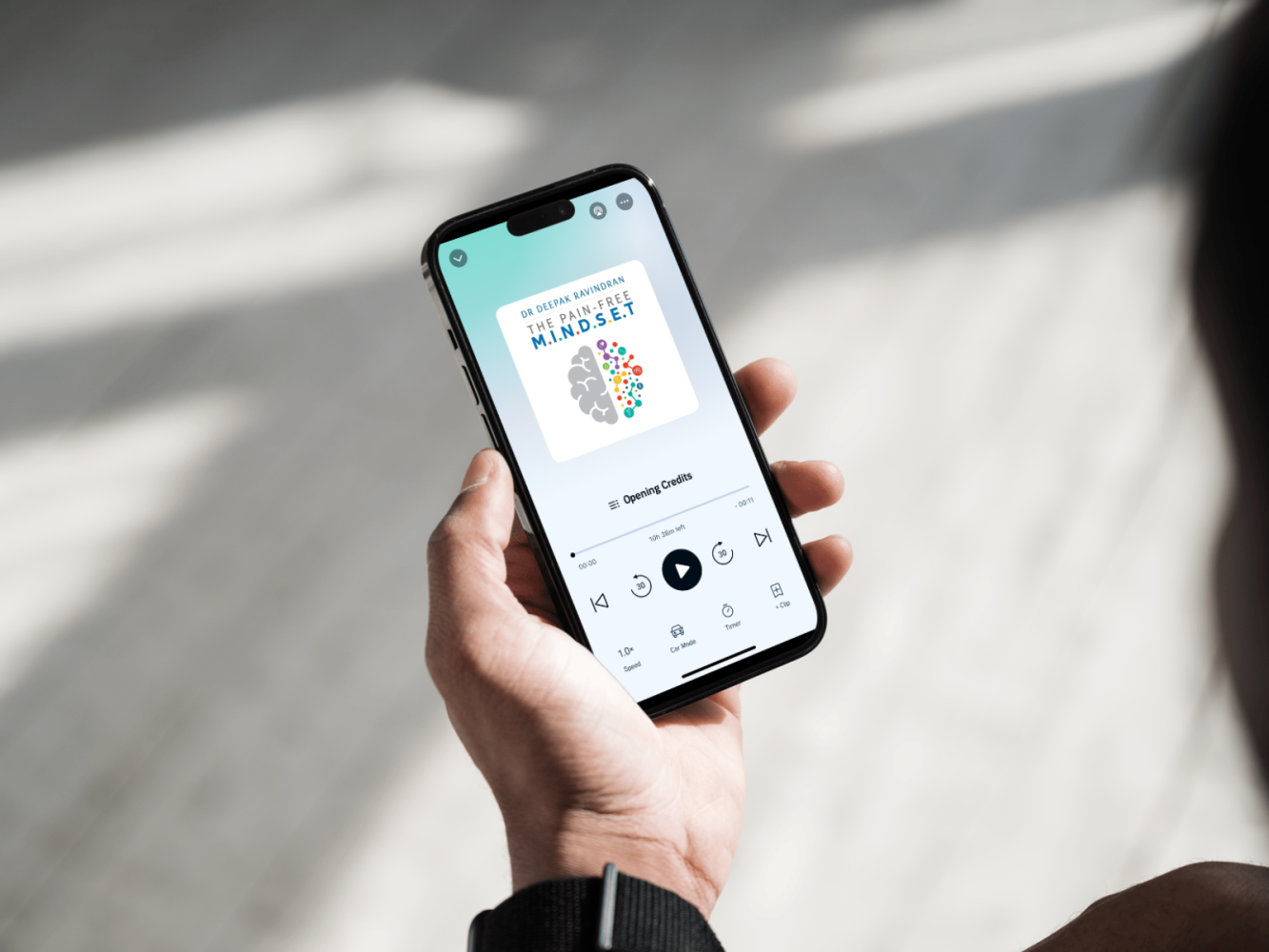
The Pain-Free Mindset, Book Review A must read for anyone still seeking answers to their persistent pain! What’s that lyric? Now the drugs don’t work,
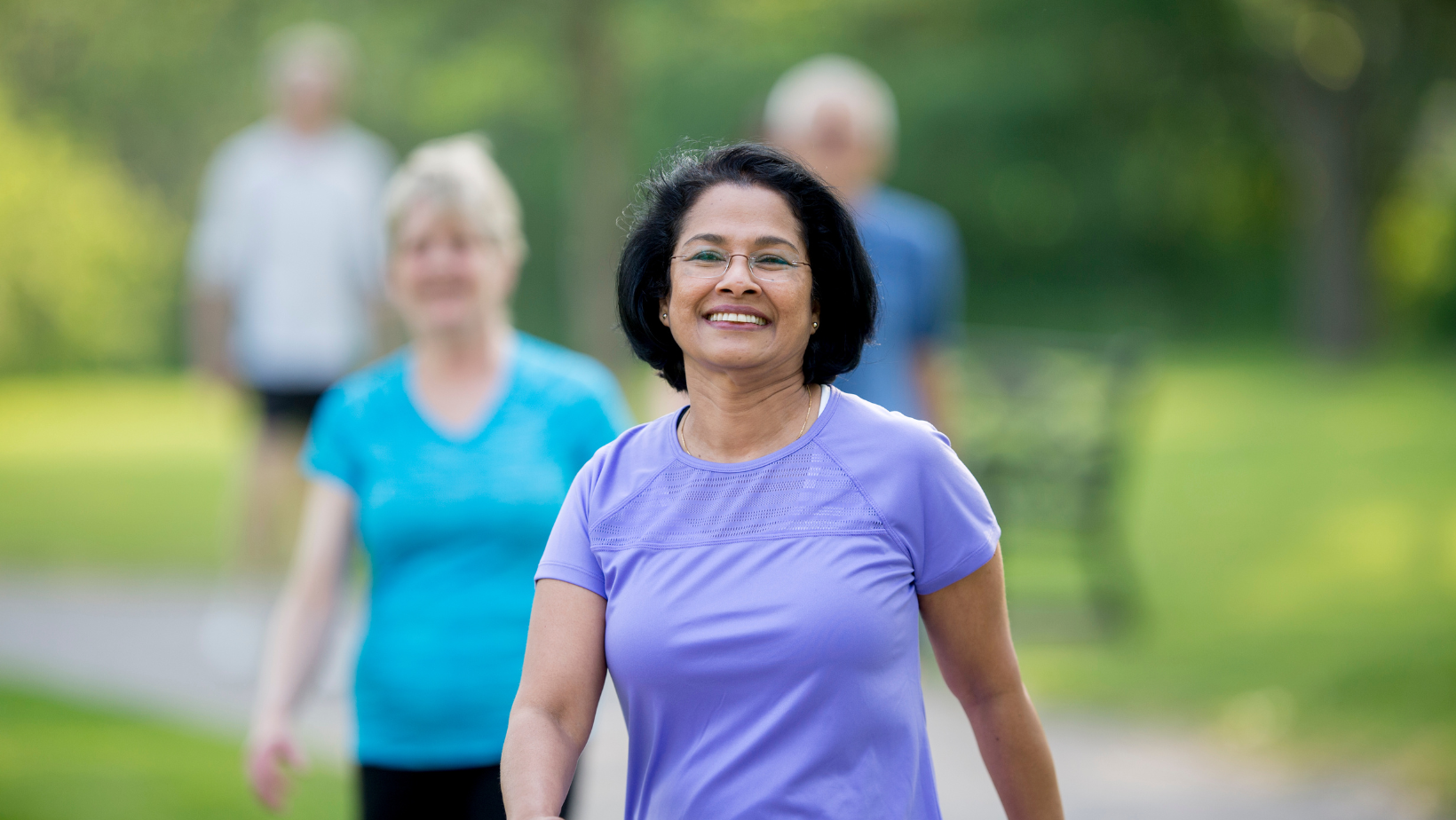
What is the best treatment for low back pain? Well it turns out it’s not drugs, injections or surgery – so what is it?

Pain and Cold Weather: Separating Fact from Fiction Home It’s that time of year! As the temperature drops, conversations about the link between pain and